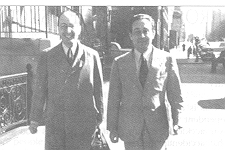
The young Wigner on the Gellért hill
Fizikai Szemle honlap |
Tartalomjegyzék |
Eugene P. Wigner
(1902-1995)
Gravity and Quantum Theory
Today the central problem of physics is that there is no common theory which could include the general relativity and quantum theory. General relativity describes macroscopic phenomena, quantum theory deals with microscopic phenomena. This division of duties is strange in physics. In most cases this duality is not disturbing, because the interest of the present physics focuses on the microcosmos and there neglecting gravity does not result in relevant error. All the other forces are 1038 times more intensive than gravity, and this is a very large number. The Basic quantity in general relativity is the metric tensor. The relation of the metric tensor to quantum theory is still puzzling. In atomic physics we do not touch the question how the metric tensor can be measured. As a matter of fact, it cannot be measured microscopically. To know the metric tensor, the distance of two space-time points should be measured. But how can we specify two space-time events? One may think upon the collisions of mass points but in quantum mechanics this would not make much sense.
The quantum behavior of gravity has not yet been demonstrated. We are convinced, however, that gravitational waves exist, and it is pretty sure that they show quantum behavior as well, in which the Planck constant plays a role. There are occasional claims that a quantum theory of gravity has been developed, but this is far from being convincing.
Let us quote an example to indicate that pure quantum theory cannot be applied to macroscopic bodies. Let us consider a 1 cm3 piece of tungsten. (This metal does not evaporate at normal temperatures.) The tungsten can be cooled to very low temperature, in order to make its state as simple as possible. If this object is placed in a vacuum chamber, the container and the support still influence its state considerably. Therefore we may imagine that this piece of tungsten is placed in intergalactic space, with the hope that in this way it can be isolated from its environment. To our surprise it turns out that the quantum state of this metallic piece will be disturbed by the cosmic microwave radiation, being present everywhere, within one millisecond. The temperature of the background radiation is about 3 K, thus 1013 photons hit the 1 cm3 tungsten in each second. And the cosmic background radiation has been influenced by the whole universe! This perturbation is practically unimportant, while we observe only macroscopic properties, but the situation is far from being satisfactory philosophically.
The greatest merit of Newton is the clean distinction between initial condition and law of motion. The initial state may be very complicated, perhaps we do not know it precisely. If we know the initial condition, according to Newton the future of the object is determined by the law of motion. (Kepler did not know this. He wanted to obtain the diameters of planetary orbits by simple law.) But initial conditions would predetermine the whole future of the object only if it were perfectly independent from its environment.
Quantum mechanics enables us to compute metallic properties like mass density or the heat of evaporation. But it makes little sense to speak about the wave function of a piece of metal. Even if we postulate that it is in a pure initial state described by a wave function, the perturbation from the environment transforms it to a density matrix. Macroscopic objects cannot be isolated from their environment, thus the domain of validity of the present quantum theory is limited. Physics has to become able to describe non-isolated objects as well!
What should be considered to be macroscopic, and what is microscopic? Where is the borderline between these two classes of phenomena? It would be very attractive to build up a theory that includes both the macrocosmos and the microcosmos. This unifying theory would be causal up to a certain degree but not strictly deterministic. If the initial state is described by a specific vector in the Hilbert space, by passing time it would transmute to a (positive definite) density matrix. It is evident that the transition between microphysics and macrophysics has to be elaborated. If that succeeds, will mean a drastic change of the present physics. The new theory will not be strictly deterministic. But we know anyway that the outcome of a card game cannot be foreseen, and the same is true for several other macroscopic phenomena.
The universe is huge, due to the weakness of the gravitational force. This has the consequence that the wave function of a macroscopic object cannot be perfectly isolated from its environment. (It can be done in a certain approximation, and that is very helpful for physicists.) This fact is usually left unmentioned in physics lectures, but it deserves attention.

The young Wigner on the Gellért hill

Eugene P. Wigner with Werner Heisenberg
Physics and Life
There are phenomena what the present physics cannot describe. One of them is the life. This circumstance is as peculiar as if physicists did not consider gravity. But gravity exists and life exists as well. Humans are here with all of their thoughts, joys and desires. It used to be said that humans obey the laws of physics and emotions do not count. This saying reminds me of the fact that 100 years ago the physics textbooks stated: "Atoms may exist but that is irrelevant for physics. " Some scientists say that emotions may influence the soul but not the motion of our hands or feet. But it is hard to accept that we are only machines. Consciousness may influence the events in the same way as gravity does. This means, however, that in shaping the future of our universe something plays a relevant role what physicists are not interested about, in a way as they were not interested about atoms 100 years ago.
Limits of the Human Intellect
One may imagine that human intellect has its limits as animal intellect has. E.g., a dog is able to learn several different things but one cannot teach a dog the multiplication table, the dog does not seem to be interested in it. In a certain sense also humans are animals. Our intellect may have its strong limitations as well. Let us hope that understanding life does not lie beyond the physicists' interest.
We are able to describe the behavior of gases and atoms. Perhaps once in the future we shall be able to understand the behavior of the human mind. But we, humans, are larger than a small piece of tungsten, thus we are under the strong influence of our environment all the time. Consequently the behavior of the human mind cannot be described by strictly deterministic equations.
It may be that the present physics will turn out to be enough to describe a bacterium. (If this is the case, it may be that bacteria will not be considered to be living creatures any longer.) But if we try to catch the real complexity of life, including consciousness, that theory will not work with pure wave functions. The transition between life and non-life may be continuous. In order to be able to develop the theory of life, the exploration of the boundary between microcosmos and macrocosmos may offer a good exercise.

Eugene P. Wigner with his friend, Leo Szilard
The Future of Physics
When a dog is not hungry any more, lies down and sleeps. Humans try to do something even when they are not hungry. This is why one may be happy that physics is not yet perfect. It is good that tasks to be done have been left!
On the other hand, physics is becoming more and more complicated, it is harder and harder to learn it. For a physicist it is almost impossible today to know the whole physics. This complexity may endanger the future of science. If people do not get an overview, may lose their interest in it. If young talents will not learn science any more that will terminate the development of physics.
One may become deeply worried that we have not yet received any message from alien civilizations. It is highly probable that there are other habitable planets, people or other smart creatures may live on them. It is likely that some of these civilizations have developed more knowledge than we have done. Therefore it is surprising that they have not yet established contact with us. One should not speculate on direct visits because of the huge distances in the physical universe. But they might use telecommunication. It would be surprising that there had been only one Earth and only one race interested in science.
There are two possible explanations for this puzzle. One possibility is that they developed science and technology in the part, they started an armament race and then they annihilated themselves. It might be, they destroyed their whole planet. If this is the rule of development of intelligence, it could explain the silence.
Another possibility is that they developed science which increased their comfort and standard of living. The achieved luxury made them lazy. They gave up reading books and studying physics. It might be that physics turned out to be too complicated for them. Thus they found it boring and lost their interest in science. This may be the reason why those, being ahead of us by 100 years or more, are not interested in contacting us.
Let us hope that this conclusion is wrong. Let us hope that the fear of an end of the story is mistaken. Who knows?
_________________________________
E.P. Wigner received the honorary Ph.D. degree from the Eötvös University and gave an acceptance lecture on the 17 November 1987. (printed in Fizikai Szemle 1988/5 p. 174) the last texts authorized by E.P. Wigner.